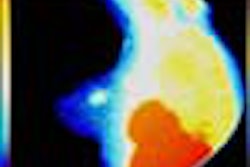The U.S. digital mammography market may soon gain another participant. Fischer Imaging has submitted a premarket approval (PMA) application to the Food and Drug Administration for the company's SenoScan full-field digital mammography system.
The FDA has committed to conducting a priority review of SenoScan, according to Fischer chairman Morgan Nields. If Fischer achieves clearance for SenoScan, the company would join GE Medical Systems as the only vendors marketing full-field digital mammography systems in the U.S. GE received clearance in January 2000 for hard-copy use of its Senographe 2000D system, with approval for soft-copy review following in November.
Fischer's PMA filing for SenoScan represents the culmination of an eight-year, $30 million odyssey for the Denver-based x-ray and mammography firm. The vendor actually began collecting clinical data for SenoScan in 1995, and had appeared close to applying for 510(k) clearance several times in the late 1990s.
But Fischer was hurt by the FDA's changing guidelines for the regulation of digital mammography. In the fall of 1999, the FDA informally suggested that vendors consider the PMA process, which would allow companies to avoid the onerous task of demonstrating substantial equivalence with screen-film mammography.
SenoScan features charge-coupled device (CCD) sensors, in contrast to several other vendors, including GE, which uses flat-panel detectors, and other firms, such as Fujifilm Medical Systems USA, which hope to apply their computed radiography technology to breast imaging.
In previous interviews with AuntMinnie.com, Fischer executives have highlighted the proven, durable, and inexpensive nature of CCD detectors. The firm also claims that CCDs generate images with very small pixels, and thus offer spatial resolution advantages over flat-panel approaches.
SenoScan generates a pixel size of 25 microns in high-resolution mode, and 50 microns in standard-resolution mode. It has a detective quantum efficiency (DQE) of 50% at zero spatial frequency, a limiting resolution of 10 line pairs/mm at standard resolution, and 16 line pairs/mm at high resolution. SenoScan generates an image size of 4096 x 5624 pixels, with a 22 x 30-cm field-of-view.
Fischer also touts SenoScan's slot-scanning technique, which involves scanning a thin x-ray beam across the breast concurrently with an array of CCDs moving below the breast. With this approach, data is collected several thousand points at a time, minimizing scatter radiation, improving image quality, and reducing dose, according to the firm. SenoScan's image receptor comfortably accommodates all women by providing for both normal and large image formats, according to Fischer director of marketing Ken Crocker.
Fischer's clinical trials included over 1,500 women, who were scanned at six institutions: University of North Carolina, in Chapel Hill; Brooke Army Medical Center, in San Antonio; Thomas Jefferson University in Philadelphia; University of Toronto at Sunnybrooke; University of California, San Francisco; and the Sally Jobe Breast Center, in Littleton, CO.
While digital mammography has been slow to develop, due in part to the high cost of the systems and low reimbursement for mammography studies, Fischer executives are optimistic about the market potential for SenoScan.
As of April 1, digital mammography exams will receive additional reimbursement, thanks to newly passed legislation. This will allow providers to more readily offset the capital cost of the systems, Crocker said. As such, Fischer believes it will be in prime position to attack the $6 billion replacement market for mammography systems in the U.S., he said.
In recent months, Fischer has been busy laying the groundwork for the commercial launch of SenoScan. At the 2000 RSNA meeting, Fischer announced a nonexclusive technology collaboration with computer-aided detection developer CADx Medical Systems of Laval, Quebec.
The companies have agreed to integrate their respective technologies, with the goal of enabling SenoScan to send images seamlessly to CADx’s Second Look CAD system. Second Look reviews digitized mammograms and highlights suspicious areas that might require further attention.
At the Chicago meeting, Nields said that Fischer had already begun taking orders from European customers for SenoScan.
By Erik L. Ridley
AuntMinnie.com staff writer
March 15, 2001
Related Reading
Film-screen mammography remains gold standard, IOM says, March 8, 2001
Fischer boosts earnings despite revenue dip, February 15, 2001
Fischer prepares for SenoScan launch with CADx deal, November 29, 2000
Full-field digital mammography is finally ready for prime time, November 16, 2000
Fischer eyes clearance for digital mammography, February 22, 2000
Click here to post your comments about this story. Please include the headline of the article in your message.
Copyright © 2001 AuntMinnie.com




















